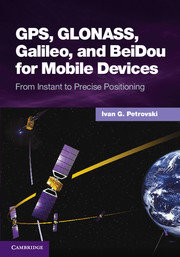Book contents
- Frontmatter
- Contents
- Foreword by Glen Gibbons
- About this book
- Acknowledgments
- List of abbreviations and acronyms
- List of definitions
- Part I GNSS: orbits, signals, and methods
- Part II From conventional to software GNSS receivers and back
- Part III Mobile positioning at present and in the future
- Part IV Testing mobile devices
- 11 Testing equipment and procedures
- Index
- References
11 - Testing equipment and procedures
from Part IV - Testing mobile devices
Published online by Cambridge University Press: 05 May 2014
- Frontmatter
- Contents
- Foreword by Glen Gibbons
- About this book
- Acknowledgments
- List of abbreviations and acronyms
- List of definitions
- Part I GNSS: orbits, signals, and methods
- Part II From conventional to software GNSS receivers and back
- Part III Mobile positioning at present and in the future
- Part IV Testing mobile devices
- 11 Testing equipment and procedures
- Index
- References
Summary
Testing procedures are an essential part of the development, manufacture, and integration of GNSS receivers into mobile devices. The core instrument for testing mobile device GNSS functionality is a GNSS simulator, and this chapter discusses their use. Readers who may be interested in in-depth information about simulators and the principles of their operation and design, should consult [1], which is also accompanied by a bundled DIF signal simulator. This chapter describes GNSS testing equipment and procedures mostly following [2]–[5].
Multi-channel simulator
Almost everything in the business surrounding GNSS can be related to either signal generation or signal processing. Simulators are used in the GNSS field mostly for testing. The methodological and research values of GNSS signal simulators are often overlooked. In [1], Petrovski and Tsujii looked at a simulator as a model of a real GNSS in order to understand better how a GNSS signal is generated and affected by various factors. Here we look at the simulator from a different perspective, as testing equipment only. Quite often, live signals from satellites are used to test GNSS devices. However, with live satellites a user has no access to the true data and no control over the signal. This leaves the simulator as an essential piece of test equipment.
- Type
- Chapter
- Information
- GPS, GLONASS, Galileo, and BeiDou for Mobile DevicesFrom Instant to Precise Positioning, pp. 293 - 310Publisher: Cambridge University PressPrint publication year: 2014



